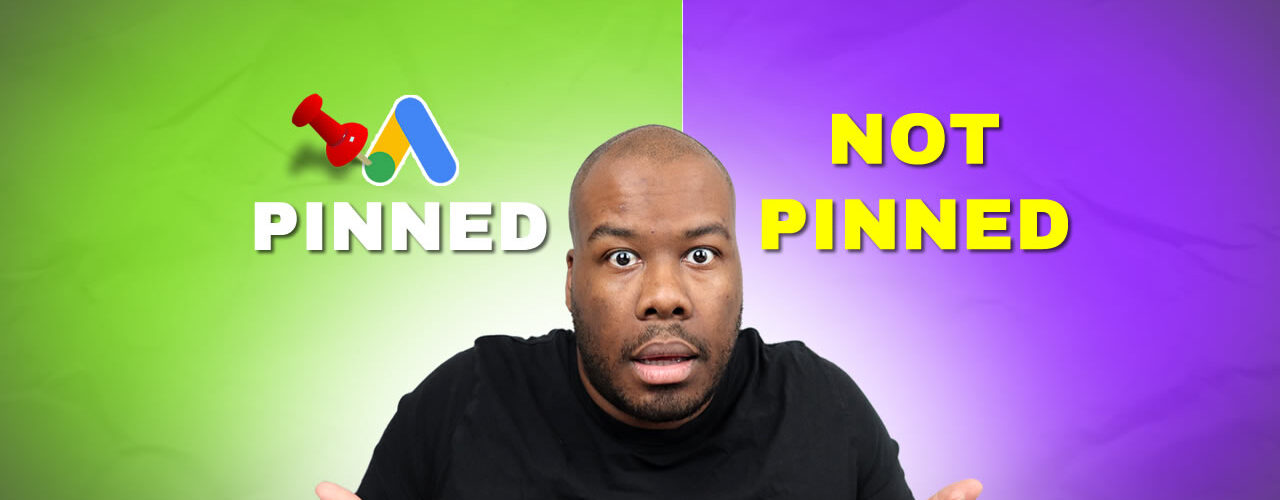Transcript – Optimizing Responsive Ads | Should You Be Pinning Your Content?
Should you be pinning your headlines and descriptions in your responsive search ads? Are you harming the performance of your search campaigns when you pin headlines and descriptions in your responsive search ads? Well, in this video, you’re gonna find out because I’m gonna show you the right way to pin content in your responsive search ads to get better results.
I’m gonna show you examples of the wrong way to do it that I’ve seen in accounts I’ve audited, and I’m also gonna cover what Google thinks about the whole pinning situation as well. And should you even be listening? to Google when it comes to whether or not you should be pinning content for your responsive search ads.
First of all, a brief description of a responsive search ad. When creating a search campaign on Google, when you get to the ad setup stage of the creation, you’ll be able to create ads using up to 15 headlines and four descriptions. That’s a lot of real estate to promote your business, especially considering how few lines can actually show on the search results page.
But actually, the reason you have so much real estate to create content is because Google will use that content to meet the objectives of a responsive search ad, and the reason they moved away from expanded text ads, which were three headlines and two descriptions, over to this new format with tons more content.
The reason Google moved to this new format is because it has the following benefits. It gives Google an opportunity to optimize the content of ads to the width of the device using and viewing the ads. It’s also supposed to reduce the amount of time you spend creating ads, because when you create that much content, you give Google a lot of ammunition to try and optimize the performance of your ads.
As opposed to creating multiple ads with three headlines only, you can get better data, apparently in Google’s eyes, using this format. And of course, with this format, with multiple headlines and descriptions, you get an opportunity to match more user queries with relevant content, getting better click through rates, and of course, Hopefully driving more conversions as well.
But what you’ll also notice is when you create these ads, you have the opportunity to pin content in place. So fixing, in position, headlines and descriptions, taking away that opportunity for Google to optimize your content. Now when I say it like that, it’s Sounds like actually, you shouldn’t be pinning your content, because if Google is so good at optimising all of those 15 headlines and 4 descriptions, then why don’t you just let Google go on and do it?
In fact, Google gives us direct feedback when we’re building ads when we start to pin headlines and descriptions, because as you start to pin content, you’ll notice… Your ad strength score start to decline from maybe excellent when you’ve got all of the ads in place, and you start pinning content that will start dropping down to average and then to poor.
And there’s a reason for that. It’s Google’s way of telling you that they don’t want you to pin content because they want to optimize all of those opportunities in the headlines and descriptions. But should you listen to them? Hmm. Kind of. And what I mean by that is, first of all, let’s understand what we mean by ad strength.
When Google gives that feedback to say your ad strength is declining when you start pinning content, all ad strength is is a measurement of how closely you’re following Google’s best practices when it comes to creating responsive search ads. They don’t affect the auction, because the auction is driven by AdRank, which is Google’s algorithm to determine how much you pay for traffic and what position your ads are going to show in.
It’s nothing to do with that, it’s just Google saying, hey, we don’t like what you’re doing, or hey, we love what you’re doing. But as an advertiser, it kind of makes sense to take advantage of Google’s algorithms when optimising ad content, but you also want to take advantage of the messaging that you know works from historical performance.
So you have to balance the two. And how do you do that? Before I get into this, if you like what you’re seeing so far, like the video and comment below whether or not you have pinned content for your responsive search ads. Let me know down below in the comments. So how can you effectively push good messaging that you know works and test new messaging content?
while also giving Google the opportunity to try and optimize based on those factors I’ve mentioned. Well, all you will need to do is give Google multiple variations of the core message you’re trying to push. Let’s use an example. Let’s use the example of an emergency plumber. One of the biggest unique selling points as an emergency plumber is no call out charges.
So a person can call you to come to attend the job. But they don’t pay just for you attending. They pay, you pay for the work. That is a big unique selling point that needs to be in ads because it’s historically proven to work. If you do a responsive search ad in the normal way, Google might rotate this unique selling point out of the ad content and harm your performance.
But, you also want Google to optimize your ad content. So what you will do in this occasion is write multiple variations of that unique selling point to enable Google to optimize the content. So instead of having one headline in the ad, which is no callout fees and pinning that piece of content once in a position in the headlines, what you could do is write three variations of that.
So say, for example, no callout fee, no callout fee, call now and no callout fee. So by doing that, you’re promoting your core USP, but you’re also providing enough differentiation in those headlines to allow Google to optimize the content and tick both boxes. You get the best of both worlds. All you need to do is pin all three headlines into the same position in the ad.
So you might want them to show first thing in position one in the first headline. All you would need to do is pin each of those individual headlines in position one. And when you do that, your ad strength score will increase and it gives Google that opportunity to optimize performance. But on the other hand, sometimes you can’t actually do this.
Maybe your USP is too long and there’s only one way to Or maybe you’re in a regulated industry like investments and securities where you have to tell people a certain message as part of the legalities of your advertising. In this scenario, you kind of just have to accept a lower ad strength score because you need to cover your bases and you need to accept that you have to show this specific message and your ad strength score will decline, but that doesn’t matter if your performance remains strong and you’re on the right side of regulations.
Do not listen to Google in that regard. Always focus on your core metrics. Park ad strength score aside, focus on click through rate and conversions and then you will be able to understand the true impact of your ad. But ultimately, when you look at the ability to pin headline content versus giving Google the opportunity to optimize, it all comes down to one thing.
You understand your business better than Google ever could, and if you want to test specific messaging in your ads, and you want to be able to see whether or not it works, you need to ignore Google. And there was a study done by PPC Tool Optimizer that proved this point. They analyzed 93,000 ads, and ads with 100 percent of the content penned, performed Best in terms of click through rate when compared to ads with some content pinned and zero content pinned.
So that is a big deal. It shows again that even though Google thinks they know what they’re talking about, sometimes they just don’t, you know, your business better. And this study shows that people pinning their content are usually people who are testing messaging and optimizing their ad performance themselves manually.
That shows that this isn’t a, is a better approach when it comes to click through rates. So why don’t you just. pin all of your content and ignore Google completely if click through rate improves significantly with pinned content. Well, that’s because ultimately it all comes down to conversions and the messaging on conversions is a bit mixed.
And that’s because ads with some content pinned as opposed to 100 percent of it pinned or none of it pinned performed best in terms of conversions. And that’s what I mean by balancing. It’s not a case of. Let’s give Google free reign to show all of the content. You still want to be able to pin content and test your headlines and descriptions as you normally would.
Even back in the day in Google Ads when you had to do that, and it didn’t have the opportunity to optimize headlines and descriptions within one ad unit, you still need to be doing that because you’re going to get better results. And this study… kind of shows that. But you need to balance it so the best approach is actually to pin some content, pin some of the key messages, but still give Google an opportunity to serve more ads and get more volume and also fit different devices and all of those good benefits that this new ad format is supposed to have.
You have to balance the two and ultimately this study shows that balancing the two gets you the best results. But let me know what you think. Do you pin all of your content and go old school, proper A B testing, every single line and description in your ads? Or maybe you’re like me and you do the best of both worlds and pin some content and then let other areas of ads continue to optimize in Google’s way.
Or maybe you don’t pin any content. Let me know which camp you’re in below in the description. I reply to all comments on all of my new videos. Like this video if you like it. Don’t forget to subscribe. Check out the other content on my channel and I’ll see you guys on the next one. Thanks for watching
Hire Me As Your Google Ads Freelancer.







